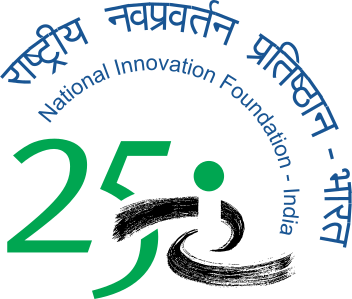Bicycle with rider and terrain induced forces for transmission system
Kanak Das (29 years), is a young innovator who symbolizes the spirit of creativity. He lives about 70 km away from Guwahati. He is a calm and quiet person albeit a little sentimental but very practical in his work. Shri Das lost his father during his childhood and was brought up by his mother who passed away recently. He is an undergraduate. He could not study science due to poverty, but has a good understanding of the subject. He sometimes watches Discovery Channel on TV and has a keen interest to develop mechanical systems by which wasted energy can be utilized for useful work. His other hobbies are singing, playing tabla and cricket. There have been occasions when he would not have enough to eat for several days. He used to spend whatever little he earned from a small area of land and a rice-processing mill that he has in the compound of his house. He lives all alone in a small house with tools and junk parts lying all over the place. He keeps a small diary in his pocket in which he notes down whenever an idea strikes him. His constant endeavor is to make everyday life of common people better by making small improvements. He has made many improvements in the rice mill also. He has attached a blower to separate chaff from the grains after milling. Bicycles continue to constitute a major means of transport by poor people in rural and urban areas. Given the uneven nature of roads, the rider on a cycle becomes very uncomfortable. Kanak Das had an old cycle, which required lot of effort to ride. He purchased a new cycle with a shock absorber, but he still wasn't satisfied. The major concern he had was that, the energy absorbed by the shock absorber was wasted. On August 15, 1999, an idea struck him about using the energy wasted in shock absorbers for propelling the rear wheel so as to supplement the pedal function. When cycle bumps on an uneven road or undulating terrain, the force induced by the bump and rider's weight is stored in a battery of six springs attached under the pedal. In the first prototype, there was a problem with reverse pedaling. It was overcome by designing a new model. Kanak Das's cycle would not slow down after bumps as conventional bicycles do. It would accelerate after every bump because of its ability to convert vertical movement due to bumps into horizontal propulsion. This could indeed become a commercial success within the country and even worldwide. Although GIAN North-East acquired his bicycle for experimental purposes, Kanak Das has a sentimental attachment to it. With great reluctance, he gave it to IIT G for modifications. GIAN team has forged active link between him and the professors from IIT-Guwahati. The improvements made so far have not satisfied him. It is not easy for an innovator to accept technical advice from outside, headstrong as the innovators generally are. But it is hoped that a fruitful cooperation will eventually emerge to make his innovation more effective by blending it with the excellence in formal sector. Director, IITG has assured full cooperation in this matter. Provisional patent has already been filed and full application will also be filed shortly. Efforts are on for technology transfer to larger commercial firms.








